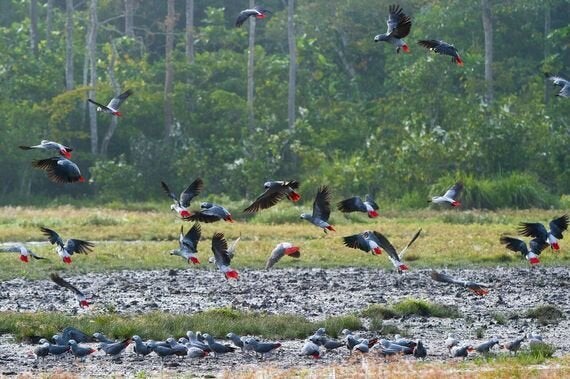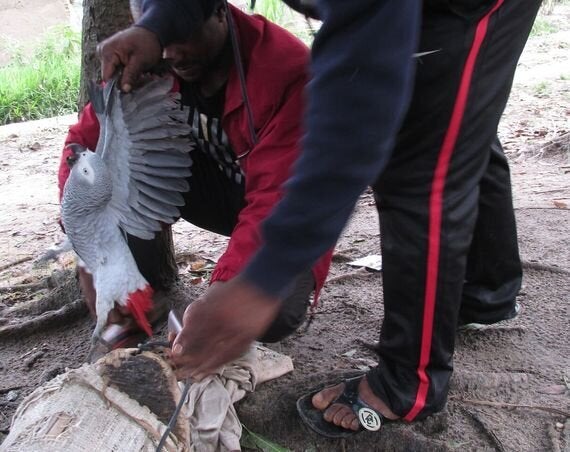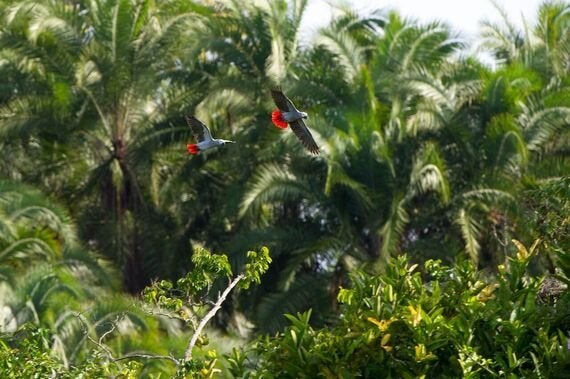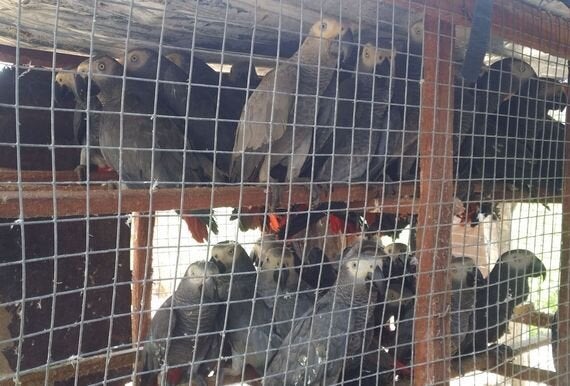
Grey Parrot numbers have collapsed in the wild, driven by a ruthless international pet trade. That is why I signed a petition initiated by the World Parrot Trust calling on countries to support a ban on the international trade in wild Grey Parrots at a forthcoming global wildlife trade meeting.
You've probably seen one in a pet shop, or maybe a friend or relative has one. They are one of the world's most handsome and familiar parrots. With slate-grey mantle, paler chest and belly and striking red under-tail, the African Grey is also very popular. These beautiful birds are hugely engaging creatures, not least because they can talk, and when I say talk I don't mean simply copy sounds 'parrot fashion': they can actually talk. Being clever and beautiful is generally a recipe for success in life, but for these birds its fast adding up to a disaster: we're loving them to death.

During the late 1980s and early 90s I worked at BirdLife International on a programme promoting the conservation of parrots. Of the 350 or so species of these birds in the world we believed about 100 of them were at risk of disappearing. Many of them were critically endangered and in imminent risk of total extinction. Although the African Grey wasn't one of them, it is now.
There were then, and still are now, two main reasons for wild parrots being in such peril. One is the destruction of their tropical forest homes and the other is the capture of birds for pets and collections. Between them these pressures have pushed many parrots to the brink of oblivion. The African Grey is at risk from both these pressures, and particularly the massive trade in birds going to pet markets.

There are solutions that can improve these birds' fortunes and over the years I've been privileged to be involved in some of them. For example, compared with the situation in the late 80s many more areas of tropical forests are protected and progress has been made toward the sustainable management of some others. Local education programmes have succeeded in discouraging farmers from shooting some of rare species and scientists have gathered a great deal more information on what's needed to conserve various threatened parrots.

On top of all of this there has been a positive impact from the adoption and implementation of international rules to control unsustainable exploitation. One way that countries have cooperated to stop it has been via the Convention on the International Trade in Endangered Species, or CITES, that can introduce bans on the trade in the most endangered species. On top of the rules operated by CITES two of what were once the biggest markets for wild-caught parrots, the US and EU, have both now banned the import of all wild caught birds, including parrots. This has helped to reduce the barbaric and unnecessary consequences that come with what has most often proved to be an ecologically damaging trade.
There is still work to do though. In some parts of its range, that runs from the tropical rainforests of West Africa through to those of the Congo Basin, the African Grey Parrot has since the early 1990s suffered declines of up to 99 per cent. Recent information collected from the field describes collapses in wild populations as a result of capture for the pet trade. Confidence in any suggestion that this might be reversed or managed to be more sustainable is undermined by irregularities in trade and exports regularly exceed recommended quotas.

Fortunately, however, even with a trade ban these birds can still be loved as pets by people around the world, but by parrots supplied from captivity. Demand in US and EU is already met by captive breeding. Between 2007 and 2013 South Africa reported the export of 158,458 captive-bred African Greys, revealing how the continuing capture of wild parrots is totally unnecessary.
Why would anyone be against such a listing? Well one group is the bird breeders. If African Greys were listed to ban the trade in wild birds then there would be a lot more paper work to prepare in getting permits to ship birds to markets overseas. It would still be legal, but more onerous. That is an issue, but in the end might not be so bad as they think. For a start they should bear in mind how their bird breeding businesses are being undermined by the supply of cheaper wild-caught parrots. They come with none of the costs they incur in taking care of the parrots and the immense time, effort and dedication they put into rearing birds that make far better pets than those wrenched from their natural habitats.
Some of the countries most important for the conservation of African Grey Parrots in the wild, including Gabon, Angola and Nigeria, are backing the proposed new listing for a trade ban and it is my sincere hope that other countries who are members of the CITES treaty won't be swayed by the short-term (and indeed wrong-headed) lobbying from bird breeders to to block it. That's why I signed that petition initiated by the World Parrot Trust.
The work of The World Parrot Trust, BirdLife International, many scientists, bird breeders and others has over the last three decades helped to avert the extinction of many species of parrots. Even some of the most critically endangered ones have begun to increase in number. The African Grey Parrot could join that group on the way to recovery and the journey might begin with this month's CITES conference and a ban on wild-caught birds being traded internationally.
